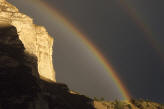Zion is located along the
edge of a region called the Colorado Plateau. The rock layers have been
uplifted, tilted, and eroded, forming a feature called the Grand
Staircase, a series of colorful cliffs stretching between Bryce Canyon and
the Grand Canyon. The bottom layer of rock at Bryce Canyon is the top
layer at Zion, and the bottom layer at Zion is the top layer at the Grand
Canyon.
Zion was a relatively flat basin near sea
level 240 million years ago. As sands, gravels, and muds eroded from
surrounding mountains, streams carried these materials into the basin
and deposited them in layers. The sheer weight of these accumulated
layers caused the basin to sink, so that the top surface always remained
near sea level. As the land rose and fell and as the climate changed,
the depositional environment fluctuated from shallow seas to coastal
plains to a desert of massive windblown sand. This process of
sedimentation continued until over 10,000 feet of material accumulated.
Mineral-laden waters slowly filtered
through the compacted sediments. Iron oxide, calcium carbonate, and
silica acted as cementing agents, and with pressure from overlying
layers over long periods of time, transformed the deposits into stone.
Ancient seabeds became limestone; mud and clay became mudstones and
shale; and desert sand became sandstone. Each layer originated from a
distinct source and so differs in thickness, mineral content, color, and
eroded appearance.
In an area from Zion to the Rocky
Mountains, forces deep within the earth started to push the surface up.
This was not chaotic uplift, but very slow vertical hoisting of huge
blocks of the crust. Zion’s elevation rose from near sea level to as
high as 10,000 feet above sea level.
Uplift is still occurring. In 1992 a
magnitude 5.8 earthquake caused a landslide visible just outside the
south entrance of the park in Springdale.
 Zion's unique
geographic location and variety of life zones combine to create a variety
of habitats for a surprising array of plant and animal species. Located on
the Colorado Plateau, but bordering the Great Basin and Mojave Desert
Provinces, Zion is home to plants from each region.
Zion's unique
geographic location and variety of life zones combine to create a variety
of habitats for a surprising array of plant and animal species. Located on
the Colorado Plateau, but bordering the Great Basin and Mojave Desert
Provinces, Zion is home to plants from each region.
Elevations range from 3600 to 8700 feet.
Within these life zones are desert, canyon, slickrock, hanging garden,
riparian, and high plateau environments. With over 900 species, Zion
National Park contains the highest plant diversity in the state of Utah.
Over 100 species of plants growing in Zion
National Park did not occur here until European settlement in the mid
1800s. Resource managers are actively removing the most aggressive
non-native species. Additionally, through a generous grant from the
National Park Foundation and the Canon Corporation, the park will be
constructing a greenhouse and nursery where native plants will be grown
for restoration projects. Campers in Watchman Campground loop D will
notice colored circles on the ground. They mark the spot where a native
plant has been carefully planted. Please help us in this restoration by
walking only on pavement or designated trails.
Fires have burned on the plateaus above Zion
Canyon for millions of years. Ponderosa pine forests are sustained by
fires which usually start from lightning strikes. All fires were
considered destructive until recently and were put out, creating unnatural
changes in the forest ecosystem. To return forests to a more natural
state, managers now use fire as a tool. Since 1991 almost 10,000 acres
have been burned in the park. All fires are closely monitored to learn
more about their ecological importance and to insure visitor safety.
Fire
is a natural part of the environment, as natural as a storm or a strong
wind. It has been an integral part of shaping the landscape over
the millennia in
every way from helping to select the plants you see to aiding the erosion
processes which created Zion Canyon.
Over the last 150 years humans have tried to manage the land
in different ways, always trying to balance our needs with what is best
for the ecosystem. At Zion people have logged, grazed, farmed, lived on
the land and suppressed fires as a part of these practices. Each activity
had its own impact and these impacts can still be seen today. Since this
land became a National Park, our needs and priorities for it have
changed. We have learned a great deal about the long term impacts of our
practices in the past and are trying to reduce them wherever possible.
The wise use of fire is an important tool in this effort.
Though fire histories done in and near the park have shown
that fire is an important part of Zion’s natural history, for many years
people have feared and suppressed it. This has led to an accumulation of
litter on the forest floor which would fuel a fire at a higher intensity
than in the days before fire suppression. Higher intensity fires present
hazards to the plants, animals, soils, and humans living in these areas.
They are also more dangerous and costly to manage or suppress, which can
present a hazard to the firefighters and taxpayers alike!

